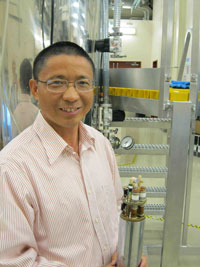| Posted: Jun 17, 2015 | |
New NMR tool helps scientists study elusive battery reaction |
|
| (Nanowerk News) When working on a unique lithium-germanide battery with colleagues from the National University of Singapore, scientists at Pacific Northwest National Laboratory encountered a catch-22: They knew an exciting reaction was occurring inside the battery that increased its energy-storage capacity dramatically-but they could not observe the reaction. The researchers needed to understand the process, but taking the battery apart caused the reaction to stop. | |
 PNNL scientist Jian Zhi Hu displays a tiny experimental battery mounted in NMR apparatus used to observe the chemical reaction inside. To solve the problem, the PNNL scientists encapsulated the battery cell in a plastic holder to allow magnetic waves to penetrate it and developed a powerful nuclear magnetic resonance (NMR) technique to "see" and understand the electrochemical reactions taking place inside. The team produced a high-storage-capacity, lithium-germanide battery and demonstrated how their unique NMR "camera" can be used to examine it and gather data about reactions that can be observed only as they are happening inside a battery ("Probing Lithium Germanide Phase Evolution and Structural Change in a Germanium-in-Carbon Nanotube Energy Storage System"). Why It Matters Lithium-ion batteries have many uses besides powering cell phones and laptops. Developing safer, more powerful cells with longer life is a worldwide challenge, requiring deeper understanding of electrochemical processes. Germanium can take on more lithium during the reaction than other materials-making it a promising component for delivering higher battery capacity and superior discharge speeds, because more lithium uptake means greater energy storage. Germanium is less abundant and more costly than other materials, such as silicon or carbon, but high battery performance resulting from its favorable uptake of lithium may be a factor in making lithium-germanide batteries attractive in the marketplace. |
|
| Methods: Scientists can create high-energy-density batteries by using lithium with a number of different materials. When the companion element-in this case germanium-takes up lithium, the volume of the electrode expands dramatically. It can break down and reduce battery life and storage capacity. | |
| By using the NMR process to look inside the battery and observe this reaction as it happened, the scientists found a way to protect the germanium from expanding and becoming ineffective after it takes on lithium. The secret proved to be forming the germanium into tiny "wires" and encasing them in small, protective carbon tubes to limit the expansion. This technique significantly stabilizes battery performance. Without embedding germanium in carbon tubes, a battery performs well for a few charging-discharging cycles, but fades rapidly after that. Using the "core-shell" structure, however, the battery can be discharged and charged thousands of times. | |
| What's Next? Scientists are testing many different materials, including sulfur, cobalt, magnesium, manganese and others, to use with lithium in making batteries. Many of these materials are potentially useful, but only those that are safe to use and offer high performance and long storage life will succeed in the marketplace. The NMR technique used to enhance the performance of the lithium-germanide reaction may prove useful to scientists working on other types of batteries if internal reactions can be observed only where they happen. | |
| "It's all about how to engineer the battery to make it safer and more powerful with a longer life," said Jian Zhi Hu of PNNL, the lead NMR investigator and a collaborator in the project with Kian Ping Loh, the leader of the team at the National University of Singapore where the battery was developed. "To reach that goal, you have to understand the electrochemistry in the battery. Using NMR to understand hard-to-observe battery reaction phases is useful when they exist only inside the battery. The procedure could lead to additional opportunities to collaborate with other researchers." |
| Source: Pacific Northwest National Laboratory |
